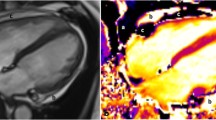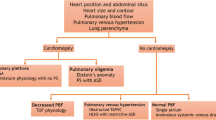Abstract
Purpose of Review
This review presents the etiology, clinical manifestations, diagnostic approach, and treatment of congenital pericardial defects. It also highlights the critical role of echocardiography, cardiac computed tomography (CCT), and cardiac magnetic resonance (CMR) in the diagnosis and management approach.
Recent Findings
Congenital pericardial defects are rare. Although most cases are found incidentally, some cases could potentially be associated with serious outcomes including sudden cardiac death. The diagnosis is often challenging due to non-specific clinical manifestations and electrocardiogram findings.
Summary
Echocardiography is the first-line imaging investigation for the evaluation of this condition. Advanced cardiac imaging modalities, including CCT and CMR, play important adjuvant roles in establishing the diagnosis and assists with prognostication.







Similar content being viewed by others
References
Papers of particular interest, published recently, have been highlighted as: • Of importance •• Of major importance
Van Son JA, Danielson GK, Schaff HV, Mullany CJ, Julsrud PR, Breen JF. Congenital partial and complete absence of the pericardium. Mayo Clin Proc. 1993;68:743–7.
Southworth HSC. Congenital defects of the pericardium. Arch Intern Med. 1938;61:223–40.
•• Khayata M, Alkharabsheh S, Shah NP, et al. Case series, contemporary review and imaging guided diagnostic and management approach of congenital pericardial defects. Open Heart. 2020;7:e001103. This study presents a contemporary natural history of the congenital pericardial defects and provides a systematic diagnostic and management approach utilizing multimodality imaging.
Bogaert J, Francone M. Pericardial disease: value of CT and MR imaging. Radiology. 2013;267:340–56.
Koo CW, Newburg A. Congenital absence of the right pericardium: embryology and imaging. J Clin Imaging Sci. 2015;5:12.
Pickhardt PJ. Congenital absence of the pericardium confirmed by spontaneous pneumothorax. Clin Imaging. 1998;22:404–7.
Kaneko Y, Okabe H, Nagata N. Complete left pericardial defect with dual passage of the phrenic nerve: a challenge to the widely accepted embryogenic theory. Pediatr Cardiol. 1998;19:414–7.
Palau P, Dominguez E, Garcia-Gonzalez P, Gallego J, Bosch MJ, Sieso E. Isolated partial congenital absence of the pericardium: a familial presentation. Can J Cardiol. 2016;32(1039):e1-2.
Murray BJ, Diamond JB, English RF. Iatrogenic pericardial defect. Ann. Pediatr Cardiol. 2021;14:105–6.
Parmar YJ, Shah AB, Poon M, Kronzon I. Congenital abnormalities of the pericardium. Cardiol Clin. 2017;35:601–14.
• Xu B, Betancor J, Asher C, Rosario A, Klein A. Congenital absence of the pericardium: a systematic approach to diagnosis and management. Cardiology. 2017;136:270-278. This review provides a systematic approach in diagnosing and managing congenital pericardial defects utilizing multimodality imaging.
Lopez DAC. Congenital absence of the pericardium. Prog Cardiovasc Dis. 2017;59:398–406.
Date N, Komatsu T, Fujinaga T. Congenital partial pericardial defect confirmed based on spontaneous pneumothorax: a case report and literature review. Int J Surg Case Rep. 2020;75:227–30.
Hano O, Baba T, Hayano M, Yano K. Congenital defect of the left pericardium with sick sinus syndrome. Am Heart J. 1996;132:1293–5.
Lee H, Jeong DS, Kim IS, Park BJ. Persistent atrial fibrillation related to a congenital pericardial defect and left atrial appendage herniation. Korean J Thorac Cardiovasc Surg. 2015;48:429–31.
Nasser WK, Helmen C, Tavel ME, Feigenbaum H, Fisch C. Congenital absence of the left pericardium. Clinical, electrocardiographic, radiographic, hemodynamic, and angiographic findings in six cases. Circulation. 1970;41:469–78.
Gatzoulis MA, Munk MD, Merchant N, Van Arsdell GS, McCrindle BW, Webb GD. Isolated congenital absence of the pericardium: clinical presentation, diagnosis, and management. Ann Thorac Surg. 2000;69:1209–15.
Furui M, Ohashi T, Hirai Y, Kageyama S. Congenital pericardial defect with ruptured acute type A aortic dissection. Interact Cardiovasc Thorac Surg. 2012;15:912–4.
Ekeke CN, Daniels C, Raman SV, Hitchcock C, Katz SE, Crestanello JA. Annuloaortic ectasia in a patient with congenital absence of the left pericardium. Ann Thorac Surg. 2013;96:2243–5.
Hojjati MR, Rozo JC, Nazeri A, Cheong BY. A rare pairing: myocardial noncompaction and congenital absence of pericardium. Tex Heart Inst J. 2013;40:500–1.
Eg B. Congenital defect of the pericardium. J Clin Pathol. 1962;15:133–5.
Boxall RO. Incomplete pericardial sac: escape of heart into pleural cavity. Trans Obst Soc (London). 1887;28:209.
Sunderland S, Wright-Smith RJ. Congenital pericardial defects. Br Heart J. 1944;6:167–75.
de Almeida Prado PS, Tavares R. Unexpected death in a newborn due to a congenital partial pericardial defect: a case report. Egypt J Foren Sci. 2022;12.
Faridah Y, Julsrud PR. Congenital absence of pericardium revisited. Int J Cardiovasc Imaging. 2002;18:67–73.
Salem DN, Hymanson AS, Isner JM, Bankoff MS, Konstam MA. Congenital pericardial defect diagnosed by computed tomography. Cathet Cardiovasc Diagn. 1985;11:75–9.
Bennett KR. Congenital foramen of the left pericardium. Ann Thorac Surg. 2000;70:993–8.
Enad JG. Partial absence of pericardium in an endurance athlete. A case report. J Sports Med Phys Fitness. 2002;42:89–91.
Panagiotopoulos N, Barnard J, Wells F. The Snoopy sign. Eur J Cardiothorac Surg. 2014;45:586.
• Klein AL, Abbara S, Agler DA, et al. American Society of Echocardiography clinical recommendations for multimodality cardiovascular imaging of patients with pericardial disease: endorsed by the Society for Cardiovascular Magnetic Resonance and Society of Cardiovascular Computed Tomography. J Am Soc Echocardiogr. 2013;26:965–1012 e15. This is the most recent published guidelines presenting the role of echocardiography, cardiac computed tomography, and cardiac magnetic resonance in pericardial disease.
Shah AB, Kronzon I. Congenital defects of the pericardium: a review. Eur Heart J Cardiovasc Imaging. 2015;16:821–7.
Flosdorff P, Paech C, Riede FT, Dahnert I. Odd acoustic window and elongated ventricles: echocardiographic diagnosis of congenital absence of the pericardium. Pediatr Cardiol. 2012;33:1220–1.
Tariq S, Mahmood S, Madeira S, Tarasov E. Congenital complete absence of pericardium masquerading as pulmonary embolism. Heart Views. 2013;14:29–32.
Alyami B, Alharbi A, Alhajji M, Gendi S, Hamirani YS. A case report of congenital absence of the pericardium that was diagnosed by cardiac computed tomography angiogram (CCTA). Radiol Case Rep. 2022;17:3380–4.
• Macaione F, Barison A, Pescetelli I, et al. Quantitative criteria for the diagnosis of the congenital absence of pericardium by cardiac magnetic resonance. Eur J Radiol. 2016;85:616–24. This study highlights the role of cardiag magnetic resonance in establishing the diagnosis of congenital pericardial defect.
Robin E, Ganguly SN, Fowler MS. Strangulation of the left atrial appendage through a congenital partial pericardial defect. Chest. 1975;67:354–5.
Miller DL, Katz NM, Kulkarni PK, Green CE. Right congenital pericardial defects. Am Heart J. 1993;126:1235–8.
Rusk RA, Kenny A. Congenital pericardial defect presenting as chest pain. Heart. 1999;81:327–8.
Author information
Authors and Affiliations
Corresponding author
Ethics declarations
Conflict of Interest
The authors declare no competing interests.
Human and Animal Rights and Informed Consent
This article does not contain any studies with human or animal subjects performed by any of the authors.
Additional information
Publisher's Note
Springer Nature remains neutral with regard to jurisdictional claims in published maps and institutional affiliations.
Rights and permissions
Springer Nature or its licensor (e.g. a society or other partner) holds exclusive rights to this article under a publishing agreement with the author(s) or other rightsholder(s); author self-archiving of the accepted manuscript version of this article is solely governed by the terms of such publishing agreement and applicable law.
About this article
Cite this article
Khayata, M., Haouzi, A.A., Asher, C.R. et al. Multimodality Imaging Approach Evaluation of the Congenital Pericardial Defect: a Contemporary Review. Curr Cardiol Rep 25, 1715–1724 (2023). https://doi.org/10.1007/s11886-023-02004-3
Accepted:
Published:
Issue Date:
DOI: https://doi.org/10.1007/s11886-023-02004-3




